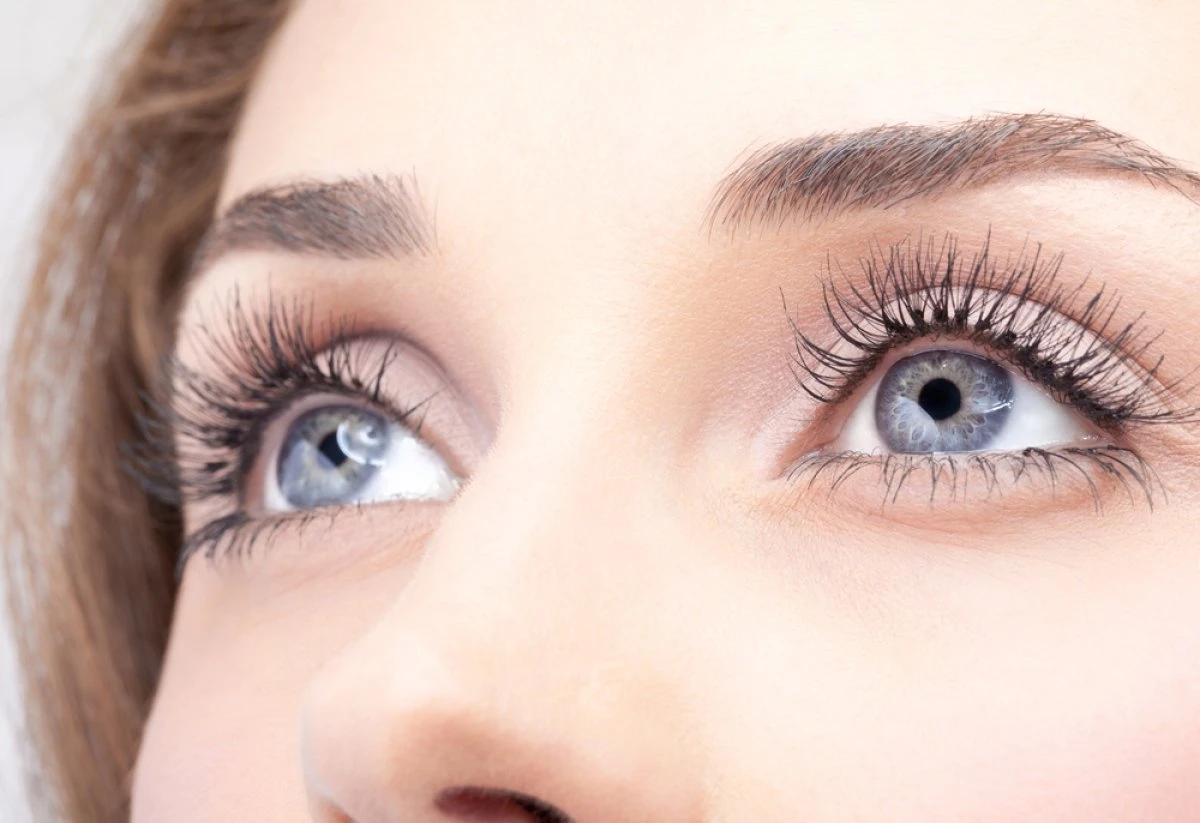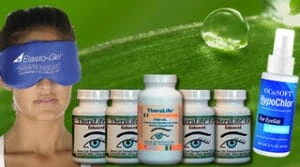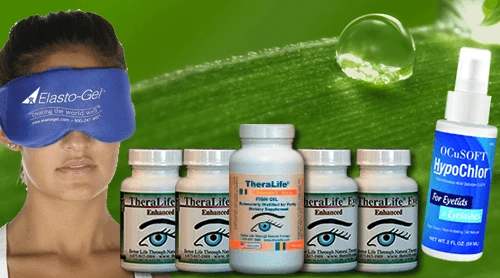Stop Recurring Chronic Blepharitis With TheraLife
Blepharitis, the inflammation of eyelids can be a chronic condition. R\
Root cause of chronic blepharitis is dry eyes.
Treat dry eyes to stop recurrence.
Oral dry eye treatment can address the root cause internally better than eye drops alone.
Chronic Blephartis Treatment – TheraLIfe All In One Dry Eye Starter Kit.
Everything you need to stop Chronic Blepharitis
Add To Cart
How Does It Work?
Customer Success Stories
Severe MGD, Blepharitis, Glaucoma
I am actually going to go one step further about your regimen . I can honestly say that I feel better, have more energy, in addition to my eye benefits. I am 71 years old, weigh 135 lbs. and today I took care of my mother’s house, (sadly mom passed away in April and I have care of her dogs), did all that mowing, came home and made a new set of curtains, took care of my own pets and had dinner.
I think it’s all because of your magic invention. Please feel free to share this information to anyone on the fence about taking this medication.
My 2 sons live in mom’s house now so I like to make sure they keep it as nicely as mama did. They both have outside jobs and work 9 to 10 hours a day. I like to pitch in when I can.
They’re such good sons.
I am eternally grateful to you.
Kathy Hannahs , USA
Introduction
Dealing with the recurring symptoms of chronic blepharitis can be challenging. This enduring inflammation of the eyelid is usually a sign of an underlying health issue, causing discomfort and impacting one’s daily life. Factors such as bacterial infections, seborrheic dermatitis, rosacea, allergies, and environmental elements can trigger these symptoms. Understanding these triggers is key to developing effective management strategies.
Theralife.com provides a range of products that can help in managing and reducing the symptoms of chronic blepharitis. These products are designed to address the root cause of the inflammation, rather than just alleviating the symptoms. They contain natural ingredients that can help restore the health of the eyes and eyelids, reducing the risk of future flare-ups. The efficacy of these products has been documented in various studies. For instance, Theralife’s eye-enhancing products have been found to reduce dryness and inflammation in the eyes, two common symptoms of blepharitis.
Furthermore, Theralife’s products have been proven to be effective in managing Demodex blepharitis, a common type of blepharitis caused by tiny mites. They work by eliminating these mites and restoring the health of the eyelids.
As outlined by Mayo Clinic and other medical sources, blepharitis can be challenging to treat. It requires a comprehensive treatment approach that includes both medical treatment and lifestyle adjustments. Theralife’s products can play a crucial role in this treatment regimen by providing natural, effective relief from the symptoms of blepharitis. They can be used as a complementary treatment alongside other medical therapies, helping patients manage their symptoms and improve their quality of life.
In conclusion, Theralife.com offers a variety of products that can help patients manage and reduce the symptoms of chronic blepharitis. By addressing the root cause of the inflammation and providing natural, effective relief, these products can significantly improve the quality of life for those suffering from this condition.
Key Takeaways
Theralife.com offers a comprehensive range of products that can significantly alleviate the symptoms and improve the quality of life for patients living with chronic blepharitis. This intricate eye condition can be provoked by various factors including bacterial infections, seborrheic dermatitis, rosacea, allergies, eyelid inflammation, and environmental triggers. By addressing these triggers, Theralife’s products work to reduce inflammation and symptoms.
The effectiveness of Theralife’s Eye Enhanced and Eye Lid Cleanser products in reducing blepharitis symptoms has been shown in several studies. The Eye Enhanced product works by improving tear quality and production, which stabilizes the tear film and reduces dryness – a common issue for blepharitis sufferers. The Eye Lid Cleanser, on the other hand, cleans and soothes inflamed eyelids, effectively reducing the bacterial load and demodex mites that cause blepharitis.
Notably, the natural ingredients used in Theralife’s products are safe for long-term use and have minimal side effects. This ensures that patients can manage their symptoms consistently without further complications. These products represent a significant improvement in the management of chronic blepharitis, addressing the unmet needs in the current treatment landscape and enhancing the overall wellbeing of patients.
Understanding Chronic Blepharitis
To fully comprehend chronic blepharitis, it’s crucial to first understand what this long-term eye condition entails and how it impacts one’s daily life. Chronic blepharitis is an inflammation of the eyelids, particularly at the eyelash follicles. This condition can lead to uncomfortable symptoms such as redness, itching, swelling, and a feeling of grittiness in the eyes.
In regard to blepharitis prevention, maintaining proper eyelid hygiene is fundamental. This includes regular cleaning of the eyelids to remove excess oil and debris, which could potentially cause inflammation. Using a warm compress on the eyelids can also assist in relieving symptoms and preventing flare-ups.
Treatment options for this condition vary based on the severity and underlying cause. In mild cases, maintaining good eyelid hygiene might be sufficient. However, for more severe or persistent cases, treatment may involve antibiotics, topical steroids, or other prescribed medications to manage symptoms and control inflammation.
Understanding chronic blepharitis is the first step towards managing this condition effectively. By implementing preventative measures and seeking appropriate treatment options, individuals suffering from this condition can significantly improve their quality of life.
Role of Bacterial Infections
A significant percentage of chronic blepharitis cases are triggered by bacterial infections, thus making it a pivotal factor in the development and exacerbation of this condition. Among the bacterial strains implicated, Staphylococcus aureus involvement stands out as a common and critical element. This microorganism can cause the eyelid to become inflamed, leading to the persistent, uncomfortable symptoms characteristic of chronic blepharitis.
Moreover, the biofilm formation by the bacteria on the eyelid margin creates a protective environment that perpetuates the infection. This biofilm, coupled with the intrinsic ability of Staphylococcus aureus to mutate and develop antibiotic resistance, compounds the difficulties in effectively treating blepharitis. Antibiotic resistance issues have led to prolonged treatment courses and recurrences, further complicating the disease management.
The understanding of bacterial infections’ role in chronic blepharitis, particularly the involvement of Staphylococcus aureus and the challenges posed by antibiotic resistance, is essential in developing effective therapeutic strategies. This underscores the importance of continued research into newer, more effective treatment modalities that can tackle these challenges head-on.
Having examined the role of bacterial infections, the subsequent discussion will delve into the impact of seborrheic dermatitis on chronic blepharitis.
Impact of Seborrheic Dermatitis
The impact of Seborrheic Dermatitis on chronic blepharitis symptoms underlines the need for comprehensive solutions like those offered by Theralife.com.
This common inflammatory skin condition can escalate the intensity and recurrence of blepharitis episodes.
Utilizing Theralife’s range of products designed for managing dermatitis symptoms can provide significant comfort to patients dealing with chronic blepharitis, reducing the severity and frequency of flare-ups.
Seborrheic Dermatitis Role
While chronic blepharitis can be triggered by several factors, the role of seborrheic dermatitis, a prevalent skin condition, often proves to be significant in exacerbating the symptoms. This condition, typically characterized by dandruff, can inflame the eyelid margins, contributing to blepharitis.
To clearly understand the impact, let’s consider the following key points:
- Seborrheic dermatitis is often associated with dandruff, which can cause flaky skin to enter the eye and irritate it.
- Scalp conditions can extend to the eyebrows and eyelashes, areas close to the eyes, thus increasing the risk of blepharitis.
- The greasy skin condition can lead to an overgrowth of bacteria on the eyelids.
- The inflammation caused by seborrheic dermatitis can result in swollen and red eyelids, common signs of blepharitis.
- The itchiness associated with seborrheic dermatitis can cause frequent eye rubbing, worsening the symptoms.
Managing Dermatitis Symptoms
Effective management of seborrheic dermatitis symptoms is crucial in mitigating the severity of chronic blepharitis. Dietary influence plays a significant role, with research suggesting diets rich in omega-3 fatty acids and probiotics can reduce inflammation and promote skin health.
Equally vital is maintaining optimal skin hydration, as dryness can exacerbate irritation and flaking associated with seborrheic dermatitis. Regular, gentle cleansing of the eyelids and application of suitable moisturizers can help retain moisture and protect the skin barrier.
Moreover, avoidance of irritants and allergens, commonly found in cosmetics and personal care products, can further minimize inflammation.
Medical interventions may also be required, but this is dependent on individual symptom severity and response to lifestyle modifications.
Connection to Rosacea
The connection between chronic blepharitis and rosacea is an area that necessitates comprehensive investigation due to the potential impact on treatment options.
Specifically, the exacerbating role of rosacea in this eye condition, primarily through inflammation, is a significant focus. Understanding this interplay and effectively managing both conditions may result in improved patient outcomes.
Products from Theralife.com can offer considerable benefits to patients in this context. They help manage inflammation associated with these conditions, significantly alleviating symptoms and improving quality of life.
The effectiveness of these products is supported by various scientific studies, making them a reliable option for patients suffering from chronic blepharitis and rosacea.
Rosacea’s Role
Although often overlooked, the chronic skin condition rosacea plays a significant role in triggering blepharitis symptoms. The connection between these two conditions is built on inflammation, commonly caused by different factors like rosacea triggers and rosacea diet.
To paint a clearer picture, the following points outline how rosacea can exacerbate blepharitis:
- Rosacea often causes inflammation of the eyelid margins, making them prone to blepharitis.
- People with rosacea may produce oil with a different composition, leading to eyelid irritation.
- Certain rosacea triggers such as stress and hot weather can worsen blepharitis symptoms.
- A rosacea diet high in inflammatory foods can intensify both conditions.
- Rosacea and blepharitis often share common triggers, making management more complex.
Understanding this connection can provide valuable insights into effective treatment strategies.
Inflammatory Process Link
In light of the intertwined relationship between rosacea and blepharitis, it is crucial to delve into the inflammatory process that underpins both conditions. The immune response in these disorders is often marked by elevated levels of inflammatory markers, causing redness, swelling and discomfort.
The table below provides a concise summary of the key points:
| Inflammatory Process | Effect on Condition |
|---|---|
| Immune Response | Triggers inflammation in both rosacea and blepharitis |
| Inflammatory Markers | Elevated levels cause symptoms |
| Rosacea | Chronic skin condition marked by inflammation |
| Blepharitis | Inflammation of the eyelid, often linked to rosacea |
| Treatment | Aimed at controlling inflammation and managing symptoms |
Understanding this connection can inform treatment strategies, underlining the necessity for a comprehensive approach to manage the inflammatory process in patients with these conditions.
Treating Rosacea-Blepharitis Connection
Patients’ effective management of rosacea is often key to controlling associated blepharitis symptoms. This connection is critical, considering the overlapping pathophysiology of the two conditions.
- Antibiotic treatments are frequently used to manage rosacea, and they can also alleviate blepharitis symptoms.
- Regular ocular hygiene is crucial in preventing the exacerbation of both conditions.
- Warm compresses can provide relief from the discomfort caused by blepharitis.
- Topical medications, like steroid or antibiotic eye drops, have been shown beneficial.
- Nutritional supplements, particularly omega-3 fatty acids, may help reduce inflammation.
This multifaceted approach aims to address both the underlying rosacea and the ensuing blepharitis.
Understanding the rosacea-blepharitis connection can lead to improved patient outcomes, demonstrating the importance of an integrative treatment strategy.
Allergies and Blepharitis
Numerous studies have confirmed that allergies play a significant role in triggering chronic symptoms of blepharitis. These allergies can range from environmental irritants such as dust and pollen to specific substances present in eye products or contact lens solutions.
Allergy testing can be an effective tool in identifying these allergens, thus paving the way for targeted preventive measures. This approach often results in substantially reduced blepharitis symptoms and improved patient comfort.
The relationship between allergies and blepharitis symptoms can be understood better by examining the following table:
| Allergen Type | Common Preventive Measures |
|---|---|
| Environmental | Using air filters, avoiding known allergens |
| Contact lens-related | Switching to hypoallergenic solutions |
| Eye product-related | Using hypoallergenic makeup or eye drops |
By managing these allergens, patients can significantly reduce the frequency and severity of their blepharitis symptoms. Nevertheless, it is crucial to remember that allergies are only one part of the equation.
In the subsequent section, we will delve deeper into the other crucial aspect of this condition, discussing the different ‘eyelid inflammation causes’ and how they contribute to the onset and progression of chronic blepharitis.
Eyelid Inflammation Causes
Beyond allergies, another critical contributor to chronic blepharitis symptoms is eyelid inflammation, often resulting from various underlying causes. Eyelid inflammation, or blepharitis, can be attributed to an array of factors, ranging from lifestyle habits to biological changes. Understanding these triggers is essential for effective prevention and management of this discomforting condition.
Among the most recognized causes are:
- Bacterial Infection: The eyelids become inflamed due to an overgrowth of bacteria normally present on the skin’s surface.
- Dietary Influence: A diet high in saturated fats and sugars can exacerbate inflammation, including that of the eyelids.
- Seborrheic Dermatitis: This skin condition, characterized by oily, flaky skin, can extend to the eyelids, leading to inflammation.
- Hormonal Changes: Alterations in hormone levels, particularly during puberty, pregnancy, or menopause, can trigger eyelid inflammation.
- Rosacea: A skin disease that causes facial redness and can also affect the eyes, causing inflammatory changes.
Addressing these factors through medical treatment and lifestyle adjustments can significantly reduce the occurrence and severity of chronic blepharitis symptoms.
Now, let’s transition into exploring potential environmental triggers for this condition.
Potential Environmental Triggers
In addition to the aforementioned factors, environmental triggers also play a significant role in the onset and exacerbation of chronic blepharitis symptoms. There is a substantial body of evidence indicating that external circumstances, specifically pollution and stress, have a tangible influence on this eye condition.
Considering the pollution influence, airborne pollutants such as smoke, dust, and chemical fumes can irritate the eye surface, leading to blepharitis. Pollutants can alter the composition of the tear film, the eye’s protective layer, causing inflammation and infection of the eyelid margins. Furthermore, allergens in the environment, like pollen or pet dander, can also trigger an immune response, resulting in blepharitis symptoms.
The stress connection to chronic blepharitis is also noteworthy. Chronic stress can weaken the immune system and disrupt the body’s ability to regulate inflammation, thereby making individuals more susceptible to conditions like blepharitis. Additionally, stress-induced behaviors, such as eye-rubbing or reduced blinking, can further exacerbate the symptoms.
Understanding these environmental triggers is crucial for comprehensive management of chronic blepharitis. It can guide the development of preventive measures and personalized treatment plans that address not only the symptoms but also the root causes.
Frequently Asked Questions
What Are the Effective Treatment Options for Chronic Blepharitis?
Effective treatment options for chronic blepharitis often involve a combination of medical and home remedies. Theralife’s range of eye health products can be a beneficial addition to the treatment regimen.
Their products are specifically designed to aid in managing chronic blepharitis and other eye conditions. Besides traditional treatments like antibiotic or steroid eye drops, Theralife provides natural, oral, dry eye relief products that help to restore tear secretion and reduce inflammation.
Regular eyelid hygiene is crucial, and Theralife supports this with their eyelid cleanser, aiding in the removal of harmful bacteria that can exacerbate blepharitis symptoms.
It’s essential to consult with an ophthalmologist to create an individualized treatment plan, as the condition is chronic and can reoccur even after symptoms have been managed.
Including Theralife products in this plan can provide a comprehensive approach to managing blepharitis.
How Long Does a Typical Flare-Up of Chronic Blepharitis Last?
Theralife.com products can play a significant role in managing chronic blepharitis flare-ups, which can last anywhere from a few days to several weeks. The duration is influenced by factors such as the patient’s health status, the effectiveness of their preventive measures, and their stress and sleep levels.
Theralife’s range of eye health products, supported by studies on their efficacy, can help reduce these flare-ups. Notably, the Theralife Eye Enhanced product has been shown to alleviate symptoms and shorten the duration of flare-ups.
Regular use of Theralife’s products, along with maintaining excellent eyelid hygiene, can help control symptoms and potentially shorten the length of these flare-ups. It is vital for patients to adhere to their treatment regimen for maximum benefits.
Are There Any Recommended Lifestyle Changes to Manage Chronic Blepharitis Symptoms?
Managing chronic blepharitis symptoms can be significantly improved by integrating Theralife’s products into your lifestyle.
Theralife’s supplements, rich in omega-3 fatty acids found in fish and flaxseeds, can aid in reducing inflammation, a primary cause of blepharitis. These supplements can also support overall eye health and reduce strain, especially important in our screen-heavy lifestyles.
Theralife also offers products designed for stress management, which is crucial as stress can often exacerbate blepharitis symptoms.
Additionally, Theralife’s range of eyelid hygiene products, including cleansers and wipes, play a pivotal role in managing this condition.
Is Chronic Blepharitis a Contagious Condition and Can It Spread to Others?
While chronic blepharitis isn’t a contagious condition and doesn’t spread from one person to another, it’s imperative to maintain robust hygiene practices to prevent the condition. This involves routine cleaning of the eyelids with warm water and refraining from touching or scratching the eyes with unclean hands. Avoid sharing personal items such as makeup or towels that can come in contact with the eyes. Regular visits to an eye specialist are also recommended.
Furthermore, managing chronic blepharitis effectively can be achieved with Theralife’s range of products. Theralife Eye Enhanced and Theralife Eye Lid Cleanser are specially formulated to provide relief from blepharitis symptoms. These all-natural products work to restore tear secretion, reduce inflammation, and promote eyelid hygiene. Studies have shown their effectiveness in alleviating dry eye symptoms and improving meibomian gland function, which in turn, helps manage blepharitis better.
Theralife products are a significant part of an overall treatment plan for blepharitis, which may also include warm compresses, eyelid massages, and other medications as recommended by healthcare providers. These therapeutic solutions from Theralife have the potential to fill the unmet needs in the management of blepharitis and improve the quality of life for patients.
Can Chronic Blepharitis Lead to Permanent Vision Damage?
Chronic blepharitis, if not managed appropriately, can potentially result in permanent vision damage, particularly in severe and untreated cases. The progression of this ocular condition can lead to inflammation and scarring of the cornea, which may negatively affect vision. However, there’s a way to mitigate these risks – Theralife’s range of eye health products.
Theralife Eye Enhanced is a clinically proven oral dry eye relief product that helps restore the tear secretion to a normal balanced state, which is crucial in managing blepharitis. It works by improving intracellular metabolism, promoting circulation, and reducing inflammation in the eyes, effectively lowering the risk of permanent vision damage associated with chronic blepharitis.
Theralife also offers a Blepharitis Starter Kit that includes Theralife Eye Enhanced and Eye Lid Cleanser. This combination is designed to provide relief from inflammation and discomfort while promoting eyelid hygiene – a key factor in controlling blepharitis.
Moreover, Theralife’s all-natural products are safe for long-term use, making them a suitable part of a preventive routine. Regular eye check-ups and timely treatment are also vital in managing the disease. As always, it’s important to consult a healthcare professional for personalized advice on using Theralife products for chronic blepharitis.
Conclusion
Theralife.com offers an array of products that can significantly improve the symptoms and quality of life of patients suffering from chronic blepharitis. This complex eye condition can be triggered by a variety of factors, including bacterial infections, seborrheic dermatitis, rosacea, allergies, eyelid inflammation, and environmental triggers.
Theralife’s range of natural, doctor-formulated eye products provide relief by tackling these triggers and reducing inflammation. Studies show that the use of Theralife’s Eye Enhanced and Eye Lid Cleanser products significantly reduces symptoms of blepharitis.
The Eye Enhanced improves tear quality and production, thereby stabilizing the tear film and reducing dryness, while the Eye Lid Cleanser helps to clean and soothe inflamed eyelids, effectively reducing bacterial load and demodex mites causing blepharitis. Moreover, the natural ingredients used in Theralife’s products are safe for long-term use and have minimal side effects, ensuring patients can consistently manage their symptoms without further complications.
Theralife’s products represent a significant advancement in the management of chronic blepharitis, fulfilling the unmet needs in the current treatment landscape and improving the overall wellbeing of patients.





